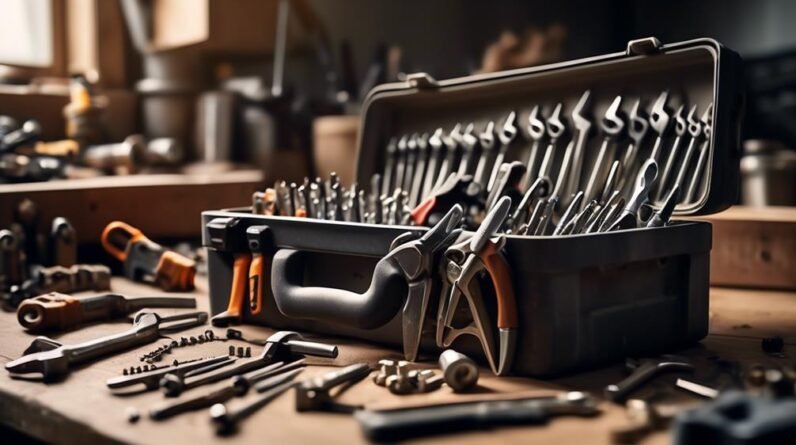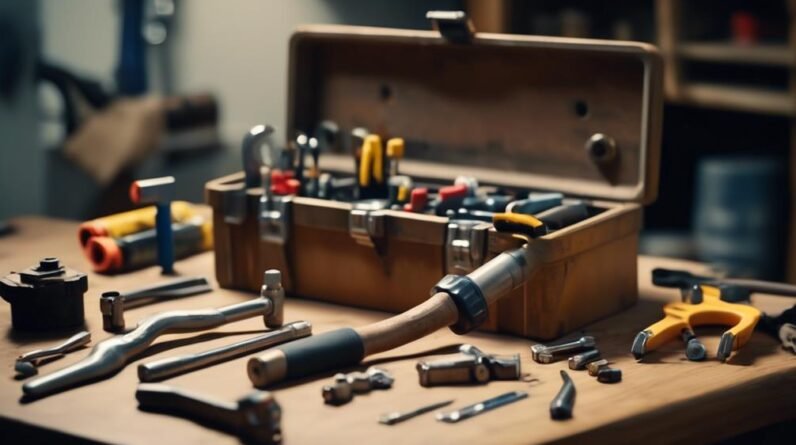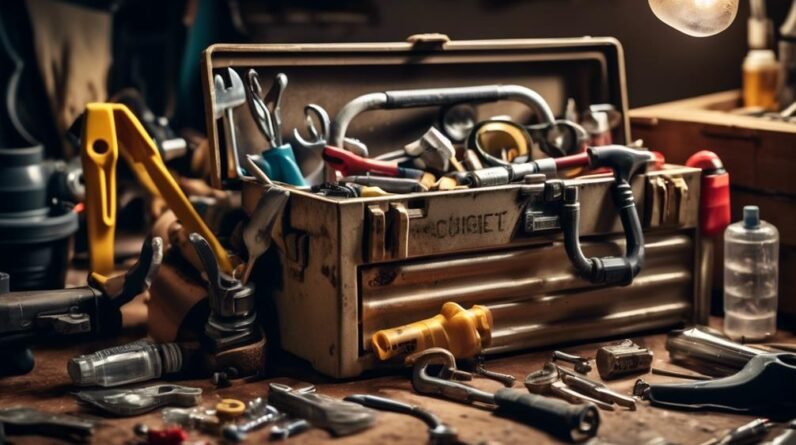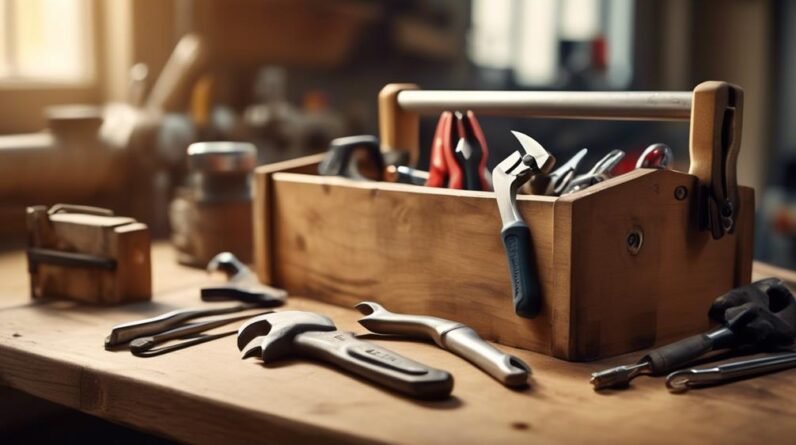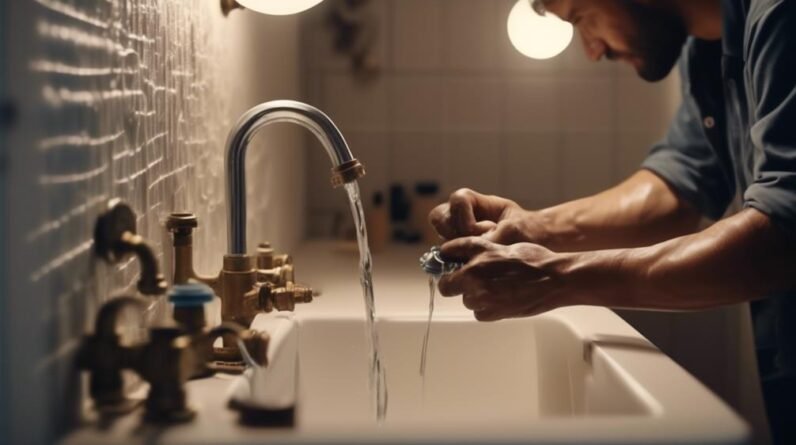
You may be thinking that home repair can be overwhelming and time-consuming. But fear not, because mastering DIY maintenance is easier than you think. With these essential home repair hacks, you'll be able to tackle common household issues, fix minor electrical problems, silence those squeaky doors and creaky floors, maintain and repair appliances, and even give your walls a budget-friendly makeover. So, why wait? Let's dive in and discover the secrets to becoming a DIY maintenance expert.
Key Takeaways
- Plumbing issues such as faucet leaks and clogged toilets can often be resolved by simple DIY methods like replacing washers or using a plunger.
- Electrical repairs should always prioritize safety precautions, and minor issues like tripped circuit breakers or malfunctioning light switches can often be fixed by homeowners.
- Squeaky doors can be fixed by lubricating hinges and tightening screws, while creaky floors can be repaired by applying wood glue or securing loose floorboards.
- Regular maintenance and troubleshooting of appliances like HVAC systems, refrigerators, dishwashers, ovens, and washing machines can help prevent major issues and prolong their lifespan.
Plumbing Hacks for Common Household Issues
If you're dealing with common plumbing issues in your home, these simple hacks can help you save time and money. Let's start with faucet leaks. A dripping faucet can be annoying and wasteful. To fix this, start by turning off the water supply to the faucet. Then, remove the handle and check for any worn-out washers or O-rings. Replace them if necessary. If the leak persists, it may be due to a faulty valve seat. Use a valve-seat wrench to remove the old seat and replace it with a new one.
Now, let's move on to toilet clogs. A clogged toilet can be a major inconvenience, but you can often fix it without calling a plumber. First, try using a plunger. Place the plunger over the drain hole and vigorously plunge up and down. If that doesn't work, you can try using a toilet auger. Insert the auger into the drain hole and rotate the handle to break up the clog. If all else fails, it may be time to call a professional.
Electrical Repair Tricks to Tackle Minor Problems
Now that you've tackled some common plumbing issues, it's time to switch gears and explore electrical repair tricks to help you handle minor problems around your home. When it comes to dealing with electrical repairs, it is crucial to prioritize home safety precautions. Before you start troubleshooting electrical circuits, always remember to turn off the power to the affected area. This can be done by flipping the corresponding circuit breaker or removing the fuse. Additionally, make sure to use insulated tools and wear protective gear such as gloves and goggles to prevent any accidents.
One common electrical issue homeowners face is a tripped circuit breaker. When this happens, it usually means that there is an overload or short circuit in the circuit. To fix this, locate the tripped circuit breaker and firmly switch it off, then back on. If the breaker continues to trip, it may be a sign of a more serious problem and it is recommended to call a professional electrician for further assistance.
Another common problem is a malfunctioning light switch. If you find that a light switch is not working, the first step is to check the light bulb to ensure it is not burnt out. If the bulb is fine, then the issue may lie with the switch itself. You can try replacing the switch or tightening any loose connections. If these steps do not resolve the issue, it is best to consult an electrician to avoid further damage or potential hazards.
Quick Fixes for Squeaky Doors and Creaky Floors
To quickly fix squeaky doors and creaky floors, try using lubricant on the hinges and applying wood glue in the gaps between floorboards. Here are four easy steps to help you tackle these common household annoyances:
- Lubricate the hinges: Squeaky doors are often caused by friction between the hinges. To fix this, simply apply a small amount of lubricant to the hinges using a spray or a lubricating oil. Be sure to open and close the door a few times to ensure the lubricant is distributed evenly.
- Tighten loose screws: Loose screws can also contribute to squeaky doors. Check the screws on the door hinges and tighten them using a screwdriver. This simple step can often eliminate the squeaking noise.
- Apply wood glue: Creaky floors are usually caused by gaps between the floorboards. To fix this, apply a small amount of wood glue into the gaps using a thin applicator. Wipe off any excess glue with a damp cloth and allow it to dry completely.
- Secure loose floorboards: If you have any loose floorboards, use a drill and screws to secure them in place. This will help prevent them from moving and causing creaking sounds.
Essential Tips for Maintaining and Repairing Appliances
Maintaining and repairing appliances is essential for their longevity and optimal performance. By following some simple troubleshooting tips for HVAC systems and effective strategies for maintaining and repairing kitchen appliances, you can save money on costly repairs and ensure that your appliances continue to work efficiently.
When it comes to HVAC systems, there are a few common issues that can be easily resolved. If your system is not cooling or heating properly, check the air filters and clean or replace them if necessary. Additionally, make sure that the thermostat is set to the correct temperature and that the vents are not blocked. If these troubleshooting steps don't solve the problem, it may be necessary to call a professional technician.
For kitchen appliances, regular maintenance is key. Here are some effective strategies for keeping your appliances in top shape:
| Appliance | Maintenance Tips | Repair Tips |
|---|---|---|
| Refrigerator | Clean the coils at least twice a year | Replace faulty seals or gaskets |
| Dishwasher | Clean the filter regularly | Check and replace worn-out spray arms |
| Oven | Use a self-cleaning function regularly | Replace faulty heating elements or sensors |
| Washing Machine | Clean the detergent dispenser and door seal regularly | Replace worn-out belts or hoses |
Budget-Friendly DIY Tricks for Painting and Patching Walls
Looking to give your walls a fresh new look without breaking the bank? Discover some budget-friendly DIY tricks for painting and patching walls to transform your space with ease and style.
- Cost-Effective Wallpaper Alternatives: Wallpaper can be expensive and difficult to remove. Instead, consider using cost-effective alternatives such as stenciling, wall decals, or fabric. Stenciling allows you to create unique patterns and designs on your walls, while wall decals offer a wide range of options for easy application and removal. Fabric can be stretched and stapled onto the wall to create a textured look.
- Tips for Removing Stubborn Wallpaper: If you do decide to go with wallpaper, removing it can be a daunting task. To make the process easier, start by scoring the wallpaper with a scoring tool or sandpaper to allow the removal solution to penetrate. Then, apply a wallpaper removal solution and let it sit for a few minutes before scraping off the wallpaper with a putty knife. For stubborn areas, use a steamer to soften the adhesive and make removal easier.
- Patch and Repair Holes: Before painting, it's important to patch and repair any holes or cracks in your walls. Use a spackling compound or joint compound to fill in small holes and cracks, smoothing it out with a putty knife. For larger holes, use a patch kit or cut a piece of drywall slightly larger than the hole and secure it in place with joint compound. Once dry, sand the patched area smooth before painting.
- Prep and Paint: Proper preparation is key to achieving a professional-looking paint job. Start by cleaning the walls with a mild detergent and water to remove any dirt or grease. Use painter's tape to protect trim, baseboards, and ceilings. Prime the walls with a primer to ensure good adhesion and even coverage. Finally, apply your chosen paint color using a roller for large areas and a brush for corners and edges. Take your time and apply multiple thin coats for a smooth and durable finish.
Frequently Asked Questions
How Do I Fix a Leaking Faucet?
To fix a leaking faucet, start by shutting off the water supply. Then, remove the handle and inspect the cartridge or washer. Replace any worn parts. Reassemble and turn the water back on. Plumbing hacks like these can save you time and money.
What Should I Do if My Circuit Breaker Keeps Tripping?
If your circuit breaker keeps tripping, it could be due to common causes like overloaded circuits or short circuits. To troubleshoot and fix it, identify the problem area, unplug or reduce the load, and reset the breaker.
How Can I Stop My Door From Squeaking?
To stop your door from squeaking, try lubricating the hinges with WD-40 or a silicone-based lubricant. Apply the lubricant to the top and bottom hinges, and open and close the door a few times to distribute it evenly.
How Do I Fix a Refrigerator That Is Not Cooling Properly?
To fix a refrigerator that's not cooling properly, start by checking the temperature settings and ensuring the vents are clear. Clean the coils and check the door seals. If the issue persists, it may require professional repair.
What Is the Best Way to Patch a Hole in Drywall?
To patch a hole in drywall, start by cleaning the area and removing any loose debris. Then, apply a patching compound using a putty knife. Smooth it out and let it dry before sanding and painting.
Conclusion
In conclusion, mastering DIY maintenance is essential for every homeowner. By learning simple plumbing hacks, electrical repair tricks, and quick fixes for common household issues like squeaky doors and creaky floors, you can save time and money. Additionally, knowing how to maintain and repair your appliances will prolong their lifespan. Lastly, budget-friendly DIY tricks for painting and patching walls will help you transform your home without breaking the bank. With these practical tips, you can confidently tackle home repairs and maintenance tasks on your own.


